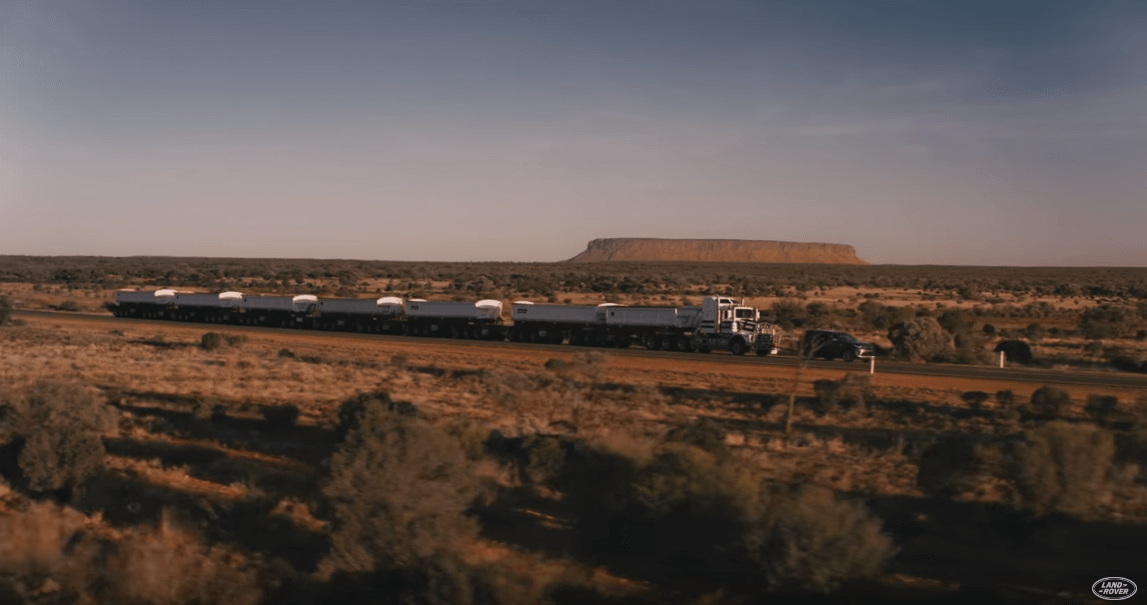I think this is pretty awesome. But I can’t help wondering how they stopped it!
Check out our full review of the Discovery here.
And here’s the video of the Discovery’s impressive feat.
Press release follows:
Land Rover Discovery Tows 110-Tonne Road Train Across Australian Outback
Discovery tows 100m-long road train weighing 110 tonnes, as Land Rover announces latest technology updates
Epic feat achieved along 16km of the Lasseter Highway in Australia’s Northern Territory to demonstrate Discovery’s award-winning towing capability
Discovery features market-leading towing tech: Advanced Tow Assist helps drivers complete tricky reversing manoeuvres by calculating the necessary steering inputs
Updated Discovery now available to order with a 12.3-inch Interactive Driver Display TFT instrument cluster, Air Cabin Ionisation and a 300PS Ingenium petrol engine
The Land Rover Discovery has taken on a 110-tonne road train and the Australian Outback… and won.
The sight of a seven-trailer truck being pulled by an SUV sounds far-fetched – but that’s exactly what happened when Land Rover put the Discovery to the ultimate towing test.
Land Rover completed the impressive display of towing capability by pulling a 100m road train in the remote Northern Territory to announce the arrival of the 2018 model year Discovery.
The Discovery Td6 has a maximum certified towing capacity of 3,500kg on public roads [1] but successfully towed a 110-tonne road train 16km along a closed section of the Lasseter Highway, thanks to its 258PS 3.0-litre diesel engine and four-wheel- drive Traction.
Road trains of up to four trailers are only permitted in Australia’s vast Outback regions and typically carry fuel, mineral ore and cattle between remote rural communities. Strict regulations limit their length to 53.5m so Land Rover obtained special permission to pull seven trailers and the 12-tonne tractor unit – retained to operate the hydraulic brakes fitted to the trailers.
“When Land Rover first got in touch, I didn’t think the vehicle would be able to do it, so I was amazed by how easily the standard Discovery pulled a 110-tonne road train. And the smoothness of the gear changes under that amount of load was genuinely impressive. These road trains are the most efficient form of road haulage on the planet and using the Discovery made this the most economical of all,” says John Bilato, managing director of Haulage Specialist G&S Transport, Took.
The extreme test was carried out using a Discovery Td6 and is the latest in a series of impressive towing demonstrations completed by the Discovery family. At its 1989 launch, the original Discovery I was used to pull a train and last year the Discovery Sport premium compact SUV towed a trio of rail carriages 85ft above the Rhine River.
“Towing capability has always been an important part of Discovery DNA and the raw weight of the road train tells only half the story here. Pulling a rig and seven trailers, with the rolling resistance of so many axles to overcome, is a huge achievement. We expected the vehicle to do well but it passed this test with flying colours, hitting 44km/h along its 16km route,” says Quentin Spottiswoode, Land Rover product engineer.
The Discovery used a standard eight-speed automatic transmission and four-wheel drive system and was hooked up to the road train using a factory-fitted tow bar attachment. The road train itself was even carrying 10-tonnes of ballast in order to hit the magic 110-tonne weight mark. With 600Nm of torque, the Td6 is well suited to pulling heavy loads. The 258PS 3.0- litre single-turbo engine features low-pressure exhaust recirculation and a two-stage oil pump for improved responses, refinement and efficiency. As a result, the diesel model delivers CO 2 emissions of 189g/km and fuel economy of 39.2mpg (7.2l/100 km).
Discovery is now available with Jaguar Land Rover’s efficient 300PS four-cylinder Ingenium petrol engine. The advanced powerplant uses Continuously Variable Valve Lift (CVVL) technology to optimise efficiency and a twin-scroll turbocharger with ceramic bearings for smooth responses and reduced friction. The new engine produces 400Nm of torque and CO 2 emissions from 219g/km [2].
In addition, Land Rover’s premium SUV gains new technologies including an Interactive Driver Display TFT instrument cluster. The state-of- the-art high-resolution panel provides contemporary graphics that create the impression of 3D surfaces with exceptional clarity and allow the driver to personalise the visual display around the two main dials.
All derivatives of the latest Discovery also feature Touch Pro infotainment with Jaguar Land Rover’s state-of- the-art 10-inch touchscreen interface on the centre console.
Digital connectivity is enhanced with the introduction of 4G WiFi, providing superior connection speeds for up to eight mobile devices on the move.
Second-generation head-up display technology also provides a full-colour display and wider functionality, even projecting 4×4 information and improved navigation displays onto the windscreen ahead of the driver, while Cabin Air Ionisation is available on Discovery for the first time, delivering improved interior air quality for enhanced passenger well-being.
Towing King: The Discovery’s Advanced Tow Assist technology takes the stress out of reversing by providing responsive trajectory lines on the rear camera feed to the central touchscreen. This allows the driver to steer the vehicle using the rotary Terrain Response 2 controller on the centre console while the system calculates the steering inputs required to achieve the desired outcome. In addition to Advanced Tow Assist, the Discovery’s award-winning towing capability also includes:
Trailer Light Test – allows customers to test their trailer lights without outside assistance
Rear Height Assist – allows the driver to lower and raise the height of the rear of the vehicle to making hitching a trailer simple
Hitch Assist – guides the driver to the trailer hitch point by displaying trajectory lines on the touchscreen feed to simplify the process
Nose Load Measurement – allows customers to quickly check the weight being applied to the vehicle tow bar to avoid dangerous overloading
Trailer Stability Assist – enhances safety on the move by detecting trailer sway and reduces the speed of the vehicle to restore control to the driver













































